Érard Frères 1811 owned by Jean-Jérôme Imbault
Description
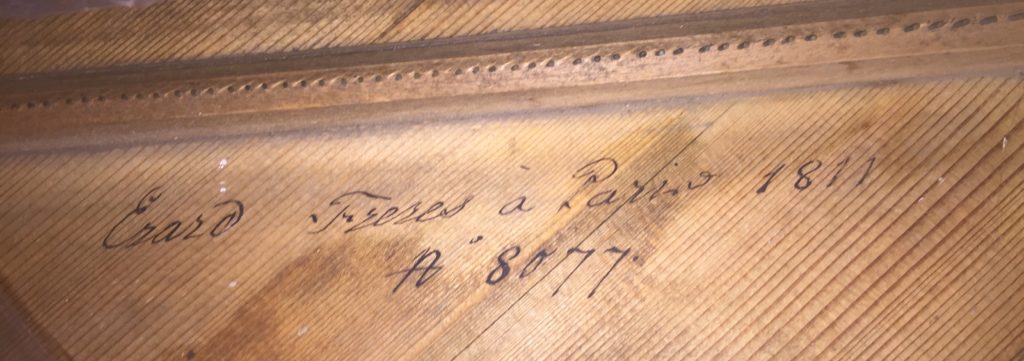
| Date: | 1811 |
| Origin: | Paris |
| Serialnumber: | 8077 |
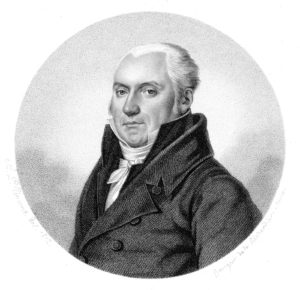
Jean-Jérôme Imbault – Engraving, 1812, after Antoine-Paul Vincent – Eric Feller Collection
This extraordinary square piano is an important historic instrument in music history, as it comes from the possession of the violinist and well-known publisher Jean-Jérôme Imbault.
The instrument by Érard Frères was made in 1811 in Paris. The case and original legs are made of mahogany. The nameboard is signed with:
“Érard Frères
Facteurs de Forte-Piano & Harpes de L.L.M.M. Imperiales & Royales
Rue du Mail No. 13 et 21 à Paris 1811″
The original keyboard has a compass of 5 ½ octaves (FF – c4) and the instrument has a “second-action” with single dampers. The keys are made from ivory and ebony. Furthermore the piano has two pedals for dampers and lute stop.
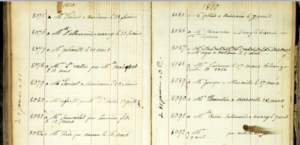
Sebastien Érard, Paris 1811, No. 8077 – Eric Feller Collection (1)
On the soundboard next to the bridge is the original handwritten signature with the serial number. The serial number is 8077. According to the original Érard production books, the instrument was sold to the violinist and well known publisher Jean-Jérôme Imbault.
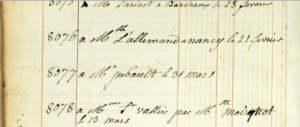
Sebastien Érard, Paris 1811, No. 8077 – Eric Feller Collection (2)
Jean-Jérôme Imbault was born on March 9, 1753. As a child he studied violin by the famous Pierre Gaviniès (1728 – 1800). At the age of 17 Imbault debuted in a public concert and on April 1, 1770, the “Mercure de France” praised him “as a talent full of hope.” Several concerts followed and he began a career as a celebrated instrumentalist. However, this success did not last long and ten years later in April 1781 the “Mercure de France” wrote less enthusiastically about him, which brought a quick end to his career. From then on, he concentrated on teaching and played in various orchestras and as a soloist (Concert Spirituel, Concert Olympique and from 1810 in the Chapelle impériale). From the beginning of the 1780s he founded a music publishing company and sold sheet music in Paris. With the help of Jean-Georges Sieber (the other great music publisher of the time), who founded his own company called “à la règle d’or” in 1771, Imbault quickly built his business up to one of the leading companies. Starting on 2 August 1783 with the publication of the second Flute Concerto by François Devienne (1759 – 1803), he worked alone since November 1784 by first publishing works by Jean-Baptiste Cartier (1765 – 1841) and André Ernest Modeste Grétry (1741 – 1813).
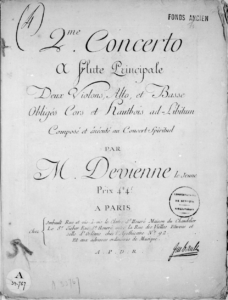
François Devienne – Title page of the 2. Flute Concerto – published by Jean-Jérôme Imbault in 1783
His company was called “Mont d’or” and was located in the Rue Saint-Honoré. In the beginning he described himself as “marchand de musique et de cordes d’instrument” and later, from 1811, as a “teacher and music publisher“.
His catalogs printed between 1786 and 1803 (but especially the catalogs from the years 1791 and 1792) contained a large number of nearly 200 instrumental works. This enormous number shows the importance he had as a publisher at that time. Among the published works were composers such as Haydn (including the Paris Symphonies), Clementi, Mozart, Viotti, Pleyel, Boccherini, Gyrowetz, Paul Wranitzky, Daniel Steibelt, Alessandro Rolla and many others. During the French Revolution he published around 100 patriotic songs. Between 1798 and 1799 he bought the business of music retailer Leblanc to have another branch which was located at Rue Favart No. 461.
Imbault had close contact with Joseph Haydn and published the Paris Symphonies, commissioned by Claude-Francois-Marie Rigoley for the Parisian “Le Concert de la Loge Olympique“. Since 1781 the “Concert de la Loge Olympique” was one of the most important and fashionable concert series in Paris (in addition to the “Concert spiritual“). It was organized by the Masonic Lodge “de la Parfaite Estime & Société Olympique” and the concerts took place at the Salle des Cent-Suisses in the Tuileries. By Symphony No. 85 Imbault wrote to the part of the first violin “La Reine de France“, which gave this symphony the nickname “La Reine“. Originally it is believed that the French Queen Marie Antoinette (who was the protector of the concert series of the “Loge Olympique“) should have particularly appreciated the symphony.
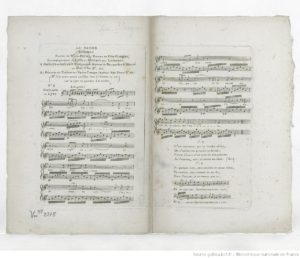
Romance “Le Baiser” by Félix Blangini (1781-1841) – Published 1811 by Jean-Jérôme Imbault
In July 1812 he sold his company to his former employees Pierre-Honoré Janet and Alexandre Cotelle and retired at Rue Saint-Honoré no. 125 where he lived off his royalties. He had no children with his wife and died on April 15th 1832.
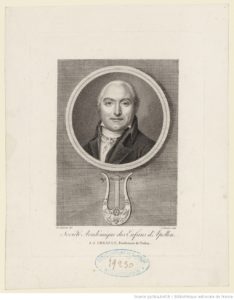
Portrait of Jean-Jérôme Imbault after F. Dumont
Here are some plate numbers from the printed sheet music by Imbault (Source: https://imslp.org/wiki/Imbault):
| Plate | Composer | Work | Year |
| 10 | Piccinni | Didon | 1784 |
| 57 | Janiewicz | 6 Trios | 1785 |
| 64 | Dussek | 3 Grand Sonatas, Op.35 | 1785 |
| 67 | Pleyel | 12 String Quartets, B.331-342 (première livraison) | |
| 87 | Pleyel | Symphony in B-flat major, B.127 | 1786 |
| 88 | Pleyel | 12 String Quartets, B.331-342 (deuxième livraison) | |
| 89 | Pleyel | Symphony in C minor, B.121 | 1786 |
| 90 | Pleyel | Symphony in B-flat major, B.125 | 1786 |
| 91 | Pleyel | 12 String Quartets, B.331-342 (troisième livraison) | 1787 |
| 93 | Pleyel | 12 String Quartets, B.331-342 (quatrième livraison) | 1787 |
| 102 | Clementi | 2 Symphonies, Op.18 (No.1, parts) | |
| 103 | Pleyel | Symphony in C major, B.128 | 1786 |
| 114 | Clementi | 2 Symphonies, Op.18 (No.2, parts) | |
| 127 | Salieri | Tarare | 1789 |
| 128 | Pleyel | Symphony in D major, B.133 | 1786 |
| 129 | Pleyel | Symphony in E-flat major, B.134 | 1786 |
| 130 | Pleyel | Symphony in B-flat major, B.135 | 1786 |
| 130 | Devienne | 6 Violin Sonatas | 1789 |
| 133 | Pleyel | Symphony in A major, B.137 | 1787 |
| 134 | Boccherini | 12 String Quartets, Op.39 (deuxième livraison) | |
| 137 | Rolla | 3 Concertant String Trios, Op.2 (BI 346, 341, 347) | |
| 153 | Haydn | Symphony No.87 in A major, Hob.I:87 | |
| 156 | Haydn | Symphony No.86 in D major, Hob.I:86 | |
| 157 | Haydn | Symphony No.84 in E-flat major, Hob.I:84 | |
| 158 | Aubert | 3 Duos, Op.6 | 1789 |
| 159 | Aubert | 3 Duos, Op.7 | |
| 171 | Pleyel | Symphony in G major, B.130 | 1786 |
| 215 | Boccherini | 6 String Trios, G.77-82 (Op.1) | 1790 |
| 259 | Pleyel | Nocturne in D major, B.201A | 1787 |
| 279 | Boccherini | 6 String Quartets, G.183-188 (Op.22) | 1800 |
| 308 | Pleyel | Petits airs et rondos d’une exécution facile (book 1) | 1791 |
| 309 | Wranitzky | Sinfonie Périodique No.2 in C minor | 1791 |
| 310 | Pleyel | Petits airs et rondos d’une exécution facile (book 2) | 1791 |
| 311 | Wranitzky | Sinfonie Périodique No.3 in F major | 1791 |
| 312 | Wranitzky | Sinfonie Périodique No.4 in A major | 1791 |
| 313 | Pleyel | Petits airs et rondos d’une exécution facile (book 3) | 1791 |
| 316 | Pleyel | Petits airs et rondos d’une exécution facile (book 4) | |
| 324 | Pleyel | Petits airs et rondos d’une exécution facile (book 5) | |
| 328 | Pleyel | Petits airs et rondos d’une exécution facile (book 6) | |
| 374 | Pleyel | Petits airs et rondos d’une exécution facile (book 7) | |
| 404 | Pleyel | Petits airs et rondos d’une exécution facile (book 8) | |
| 420 | Reicha | 12 Fugues for Piano | |
| 440 | Gaviniès | 24 Matinées | |
| 461 | Jadin | Duo for Piano Four Hands | 1796 |
| 469 | Aubert | 25 Studies, 3 Duets and 3 Sonatas, Op.8 | |
| 481 | Demar | Clarinet Concerto in E-flat major | |
| 483 | Pleyel | Petits airs et rondos d’une exécution facile (book 9) | |
| 486 | Pleyel | Petits airs et rondos d’une exécution facile (book 10) | |
| 487 | Pleyel | Petits airs et rondos d’une exécution facile (book 11) | |
| 495 | Devienne | Symphony in D major ‘La Bataille de Gemmapp’ (parts) | 1794 |
| 573 | Hoffmeister | 6 String Quartets, Op.7 (parts) | 1785 |
| 578 | Bréval | Cello Concerto No.6, Op.26 | |
| 591 | Bréval | 3 String Trios, Op.39 | |
| 608 | Demar | Horn Concerto in D major | |
| 670 | Janiewicz | Violin Concerto No.4 in A major | 1797 |
| 672 | Demar | 6 Clarinet Duos | |
| 680 | Devienne | 6 Flute Quartets, Op.66 (part 1) | 1799 |
| 687 | Cherubini | Médée | 1798 |
| 704 | Devienne | 6 Flute Quartets, Op.66 (part 2) | 1799 |
| 711 | Demar | Méthode abrégée pour le violon | |
| 718 | Demar | 40 Violin Duos d’airs choisis | |
| 738 | Cimarosa | Il matrimonio segreto | 1799 |
| 751 | Fuchs | 6 Duos formant vingt quatre morceaux, Op.36 | 1799 |
| 752 | Fuchs | 3 Quartets for Horn and Strings, Op.31 | 1799 |
| 759 | Punto | Horn Concerto No.11 | 1799 |
| 837 | Davaux | 3 String Quartets, Op.17 | 1807 |
Detailed information about the company Erard Frères can be found in our publications here!
Further preserved instruments by Erard Freres:
- 1805 square piano (No. 6447) – Museum für Kunst und Gewerbe Hamburg, Germany
- 1823 square piano (No. 11492) – Cité de la Musique Paris, France
Sources:
- Benton Rita : “J.-J. Imbault (1753–1832), violoniste et éditeur de musique à Paris”, Revue de Musicologie, vol. 62, No 1, 1976, pp. 86–103.
- Benton Rita: The New Grove Dictionary of Music and Musicians (edited by Stanley Sadie): “Imbault, Jean-Jérôme”, London, Macmillan, second edition, 2001.
- Devriès Anik and Lesure François: Dictionnaire des éditeurs de musique français. Vol. 1. Genève, Éditions Minkoff, 1979.
- Gribenski J.: Un métier difficile: éditeur de musique à Paris sous la Révolution, Le tambour et la harpe, Lyon, 1989. Éd. J.-R. Julien et J.-R. Mongrédien, Paris, 1991.
- Guiomar Paule : “J.J. Imbault”, Fontes Artis Musicae, vol. 13, no 1, 1966.
- Konold Wulf: Sinfonie Nr. 85 B-Dur (Hob. I:85) „La Reine“ In: Wulf Konold (Hrsg.): Lexikon Orchestermusik Klassik A – K. B. Schott´s Söhne, Mainz 1992.
- Nakano Hiroshi: Pariser Sinfonien Folge 1. In: Joseph Haydn-Institut Köln (Hrsg.): Joseph Haydn Werke. Reihe 1, Band 12. G. Henle – Verlag, München 1971.
- Vanhulst Henri: Un catalogue manuscrit de Jean-Jérôme Imbault postérieur à 1812, in “Noter, annoter, éditer la musique : mélanges offerts à Catherine Massip” (Paris: BnF ; (coll. “Hautes études médiévales et modernes” (no 103) Genève, Droz, 2012) pp. 429 – 446.
- Walter Michael: Haydns Sinfonien. Ein musikalischer Werkführer. C. H. Beck-Verlag, München 2007.
© Eric Feller – Early Keyboard Collection – December 2018
| Length: | 166 cm |
| Width: | 64,5 cm |
| Height: | 24 cm |
| Circumference: | 5 ½ octaves (FF - c4) |
| Mechanics: | second action |
| Pedals: | 2 pedals– dampers, lute |
| Signature: |
"Erard Frères Facteurs de Forte-Piano & Harpes de L.L.M.M. Imperiales & Royales Rue du Mail No. 13 et 21 à Paris 1811" |

